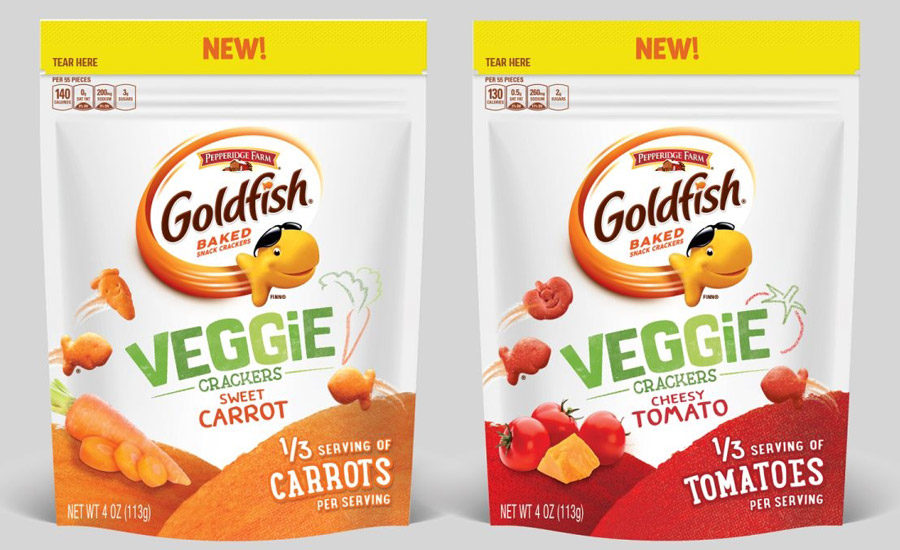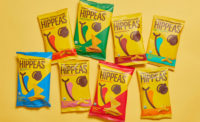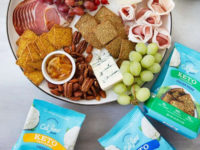Crackers are a product category that has nearly universal appeal. Consumers are snacking more often, especially in light of the recent pandemic, and the expanding variety of crackers on the market today make them a natural fit for nearly any snacking occasion.
But while crackers are a well-positioned snackable food, increased competition in the category will require innovation that explores new flavors, formats, textures, and functional benefits.
Overview | Chips | Puffed/Extruded Snacks | Popcorn | Snack Mixes & Nuts | Tortilla Chips | Pretzels | Frozen Snacks | Crackers
Market data
The cracker category experienced solid growth of 5.9 percent resulting in $7.8 billion in sales, based on the latest 52 weeks period ending May 17, 2020, per IRI, Chicago. Every key segment within the cracker category experienced growth during this time period.
The largest cracker segment, “all other crackers,” grew 6.1 percent to $5.7 billion in sales. The top four leaders in the category, which represent almost 80 percent of the market, realized growth. Mondelez grew 6.9 percent to $1.7 billion, the Kellogg Co. increased 6.5 percent to $1.6 billion, Pepperidge Farm was up 7.6 percent to $956.8 million in sales, and private label gained 7.2 percent to $250.9 million.
The dominant brand in the category, Kellogg’s Cheez-It crackers, saw double-digit growth of 10.8 percent leading to $912.0 million. The Cheez-It Grooves brand was up a nominal 0.5 percent, contributing $102.3 million to company sales. Keebler brand Club crackers saw nice growth of 11.5 percent to $259.1 million.
All three top-tier cracker Nabisco brands from Mondelez realized growth: Ritz crackers grew 9.8 percent to $570.0 million, Triscuit grew 3.2 percent to $336.7 million, and Wheat Thins grew 9.9 percent to $312.5 million. Ritz line extensions also performed well, with Ritz Fresh Stacks growing 4.7 percent to $157.4 million and Ritz Toasted Chips growing 14.3 percent to $91.3 million.
Pepperidge Farm Goldfish crackers were up 5.9 percent to $608.3 million, and Pepperidge Farm Flavor Blasted Goldfish grew 18.6 percent to $175.6 million.
Gluten-free is also performing well, as evidenced by the second year in a row of double-digit growth for Blue Diamond Nut Thins, increasing 13.2 percent to $78.8 million.
The crackers with fillings segment reversed a year of declines from 2019 with a segment increase of 2.3 percent to $1.1 billion in dollar sales. Segment leader Snyder’s-Lance, part of Campbell Snacks, grew 5.4 percent to $349.7 million. Both Lance Toast Chee and Lance Captain’s Wafers cracker lines grew 7.3 percent, taking in $125.4 million and $66.5 million, respectively. The Lance Toasty brand grew 1.4 percent, adding $72.0 million in revenue.
Mondelez experienced strong growth for its crackers with fillings, up 13.5 percent to $282.6 million. Its Nabisco Ritz brand led the way, up a very strong 15.9 percent to $176.8 million. Ritz Bits likewise had a strong year, up 10.3 percent to $75.3 million.
Another bright spot in crackers with fillings was Ferrero’s Nutella & Go brand, increasing 6.7 percent growing to $80.6 million.
The saltines segment grew 7.2 percent to $533.5 million. Mondelez, the dominant category leader with almost 60 percent market share, grew 10.2 percent to $319.4 million, all from its Nabisco Premium Saltine crackers brand. Grupo Gamesa—a Mexican subsidiary of PepsiCo—saw another year of strong growth, up 30.9 percent to $12.9 million.
Coming off a year of declines the prior year, the graham cracker segment experienced double-digit growth of 11.4 percent, resulting in $461.1 million in dollar sales, per IRI. Mondelez, the category leader, drove the growth increasing dollar sales 13.0 percent to achieve $321.0 million. The company’s flagship Nabisco Honey Maid brand contributed 13.7 percent growth leading to $274.3 million in sales. Private label also fared well, increasing 10.0 percent to $81.7 million. Kodiak Cakes—the 2020 SF&WB “Bakery of the Year”—had a strong entrance to the segment last year with $2.7 million in sales for is protein-enriched graham crackers.
Looking back
“Plant-based eating is now a mainstream movement,” says Carla King, senior marketing manager, Mary’s Gone Crackers, Reno, NV. “U.S. retail sales of plant-based foods significantly outpaced overall grocery sales in the past year, surging 11 percent to $4.5 million. While these statistics are pre-COVID-19, we have seen an uptick in demand since the shelter-in-place began, and have yet to see a drop-off.”
Mary’s Gone Crackers creates its original crackers with organic, gluten-free, whole-grain brown rice, quinoa, flax seeds, and sesame seeds to create a cracker with a rich, earthy flavor. The company’s Super Seed crackers feature a combination of whole-grain quinoa, pumpkin seeds, sunflower seeds, brown sesame seeds, brown flax seeds, and poppy seeds, providing 5 grams of plant-based protein in every serving. The line includes several varieties: Classic, Basil & Garlic, Everything, Seaweed & Black Sesame, Rosemary, Chili Lime, and Lemon Dill. Its Real Thin Crackers provide the taste and texture of a thin, rectangular cracker without the wheat. The company is working on three new line extensions: Tomato Basil, Chipotle and Olive Oil, and Cracked Black Pepper, set to ship in September 2020.
In addition to incorporating plant-based nuts and seeds to crackers, manufacturers are innovating through the addition of vegetables. Simple Mills is launching a new whole-food Veggie Pita Cracker that is designed using a unique sweet potato, parsnip, and celery root blend that delivers one-third of a serving of sweet potato in only 9 crackers. These veggie-powered pita crackers are vegan, Non-GMO Project Verified, and certified gluten-free, available in: Himalayan Salt, Mediterranean Herb, and Roasted Red Pepper.
Pepperidge Farm, part of Campbell Snacks, recently introduced Goldfish Veggie crackers in two varieties: Cheesy Tomato and Sweet Carrot. Each serving delivers one-third of a vegetable serving.
Looking forward
Lifestyle and dietary choices are front and center with consumers. “We have seen a rise in foods that promote better gut health and higher fiber as some key trends for 2020 and 2021,” says David Guilfoyle, innovation manager, bakery and fats/oils, DuPont Nutrition & Biosciences, New Century, KS. “People are becoming aware that improving gut health is a lifestyle change, and consumers are moving in that direction to feel better. As COVID-19 has created a new normal in our daily lives, people are focusing on themselves and improving their lifestyles, not only in exercising, but more so on improving their diets. Crackers can play a large role on improving gut health, as consumers expect the category to deliver a snackable food containing some health benefits. Crackers are a highly sought item in the grocery stores right now, and offering more gut-healthy alternatives can help take this category and grow it even larger.”
In addition to gut health, protein continues to be of interest to consumers. Crackers are a great platform to incorporate protein. Product developers can add protein to crackers via various ingredient formats, notes Guilfoyle, including as a powder in the formulation or as a topical addition to the cracker.
“Gluten-free crackers continually grow in popularity,” says Guilfoyle. “Gluten-free has challenges with being able to laminate the dough properly and maintain good structure in a cracker.” Using Methocel, a line of modified cellulose, can help with the sheeting and laminating of gluten-free dough for crackers, helping provide good structure, he explains. The ingredient has multiple functional benefits, including the ability to mimic the water-absorbing and structural characteristics of gluten to deliver superior gluten-free baked products.
Maintaining efficient operations and minimizing downtime, as well as improving equipment reliability, safety, and sanitation, can help give cracker producers a competitive edge. This has become even more important in light of the recent pandemic. SEPCO, Alabaster, AL, recommends its SAS Air Seal for mixers handling dry ingredients and slurries. “The SAS is an engineered pneumatic sealing system, designed to seal the shafts of equipment where typical contact seals such as packaging and/or mechanical face seals prove to be too costly to operate and maintain,” says Zach Nepa, regional manager. “The noncontact SAS air seal completely seals the mixer and does not allow any ingredients to exit the shaft. The mixer will not need to be shut down for maintenance, and housekeeping and contamination issues are eliminated. The SAS air seal never needs maintenance or replacement if operated as designed. This makes it a real game-changer in the realm of reliability.”
Looking forward, King believes that plant-based offerings are likely to show up in more mainstream categories, competing directly with animal-based products. “I believe plant-based snacks and comfort foods will also gain greater acceptance,” she says. “Additionally, the protein source is likely to move away from traditional soy to innovative blends of grains with pea, mung bean, or garbanzo beans.”
Guilfoyle sees vegan as an emerging trend that will continue to grow. “There is renewed interest to put more vegan products on the grocery shelves. Capitalizing on this trend should be an easy fit for the cracker category, and promoting vegan in this aisle will certainly bring more interest back to the center aisles again.”
Overview | Chips | Puffed/Extruded Snacks | Popcorn | Snack Mixes & Nuts | Tortilla Chips | Pretzels | Frozen Snacks | Crackers










